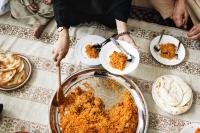By Breanne Vailes
With the U.S. holiday season’s meals and traditions approaching, some Plaza staff started a conversation about what eating together means in their cultures. This is a two-part blog depicting Plaza staff’s perspectives, with the first focusing on family mealtimes and the second including larger communal meal settings. Heartfelt thanks goes to the following contributors -- Walid Alani (Iraq), Ernesto Escarsega (Mexico), Senaye Gebremichael (Ethiopia), Deeksha Nagar (India), and Warren Ramos (Philippines).
Every contributor touched on a major theme -- the idea of togetherness. People within these cultures always eat with others. Senaye shared that family members are “not meant to eat alone” and it is “actually frowned upon if you’re eating by yourself.” Deeksha similarly shared, “When we are traveling by train, people share food with each other. It is not regarded as appropriate to eat by yourself without offering food to a person sitting next to you in public spaces such as a park or in a bus.”
Food and Relationships
The physical act of sharing food reinforces relationships in Ethiopia and India. For instance, someone in Ethiopia can place a bite of food into another person’s mouth as a sign of respect in an action called “gursha” which means “give thanks.” People do this for friends, family members, and even those they just met. To accept is to partake in mutual respect and thanksgiving, and to reject the offer is a sign of disrespect. Deeksha shared that her grandmother showed love by feeding her grandchildren by hand.
Relational Meal Settings
On a practical level, the orientation of the meal setting itself can be communal. For example, with all of the food in the middle of the floor, the host divvies out the food within Arabic culture, and, as for utensils, family members partake from a shared dish with their hands. Similarly, Ernesto shared that eating with tortillas instead of utensils is common in Mexico. From Deeksha’s experience, implements such as forks and spoons are a sign of modernity in India, but eating by hand is seen as the way to truly participate in a traditional meal.
Cultural Values at Mealtime
Family meals often display the principles and beliefs of a culture. In Warren’s and Ernesto’s families, the meal always begins with saying grace. According to Deeksha, in traditional Hindu families, the first bite of food either is placed on the floor to honor Mother Nature or is given to the birds. Warren shared that wasting any food, even a few grains of rice, would be shameful in his Catholic culture. In addition, mealtime superstitions in the Philippines are said to predict who will arrive. If a fork is dropped on the ground, a man will arrive, and a spoon foretells that a woman will.
All of these cultural experiences indicate that family meals are more than opportunities for nutritional nourishment, mealtimes display deep meaning of respect and care for one another. At the heart of the traditions above, people need other people in order to survive. As humans must eat to live, people in these cultures must eat together to live well. Mealtimes and community -- there is not much of a difference between the two.
Plazas are an open community space where migrants from all over the world connect with people, information, and resources, building Denver’s global community. Come to practice a language, prepare for citizenship, pursue your goals, and create your future. Whatever you’re doing, we can help! Please see our web page for more information.
TIP: To learn more about world food traditions, try searching our catalog for "food habits," plus the region or country you are interested in. For instance, "Food Habits - India." To check out an item, simply place it on hold, and make an appointment for curbside pickup!
